AI
our blog
7 Steps to Launch Your Software Development Business Successfully

Overview
The primary focus of the article '7 Steps to Launch Your Software Development Business Successfully' is to delineate a structured approach for effectively starting a software development business. This comprehensive guide encompasses:
- Defining business goals
- Establishing legal structures
- Developing a business plan
- Securing funding
- Recruiting a development team
- Implementing marketing strategies
- Protecting intellectual property
Each step is essential for overcoming common startup challenges and achieving long-term success. By following these outlined steps, entrepreneurs can navigate the complexities of launching their business with confidence.
Introduction
Launching a software development business presents an exhilarating yet daunting venture, particularly in a landscape where innovation is paramount to success. Aspiring entrepreneurs possess a unique opportunity to carve out their niche by addressing specific market needs and leveraging their expertise. However, with a staggering statistic indicating that 50-70% of software projects fail due to unclear goals and poor communication, how can one ensure their startup not only survives but thrives?
This article delineates seven essential steps that guide entrepreneurs through the complexities of establishing a successful software development business, from defining a compelling business concept to securing funding and navigating legal requirements.
Define Your Business Concept and Goals
-
Identify Your Niche: Begin by analyzing the software landscape to uncover gaps where unique solutions can be offered. Utilize your interests and expertise to ensure that your passion drives your business. The vastness of the internet means that even small niches can yield unexpected profitability, as they often address specific needs that larger markets may overlook.
-
Define Your Value Proposition: Clearly define what differentiates your application from competitors. This may involve innovative features, an exceptional user experience, or cost-effectiveness. A robust value proposition is crucial, especially in a landscape where 50-70% of projects fail due to unclear goals and ineffective communication. At Studio Graphene, we advocate for a holistic approach that encompasses Discovery, Design, and Build services, ensuring that your software distinguishes itself in the market by addressing specific client challenges at every stage.
-
Set SMART Goals: Formulate Specific, Measurable, Achievable, Relevant, and Time-bound goals to steer your strategy. These objectives will assist in tracking progress and evaluating success over time, ensuring your efforts are aligned with your overarching vision.
-
Create a Vision Statement: Compose a succinct vision statement that encapsulates your long-term aspirations for the company. This statement will serve as an inspirational guide for you and your team, providing clarity and direction as you navigate the complexities of the tech industry. With the market projected to grow significantly, boasting a compound annual growth rate of 22.5% for custom applications from 2024 to 2030, possessing a clear vision will strategically position your enterprise for success. Leveraging Studio Graphene's expertise in tailored digital product development can further enhance your strategic positioning.
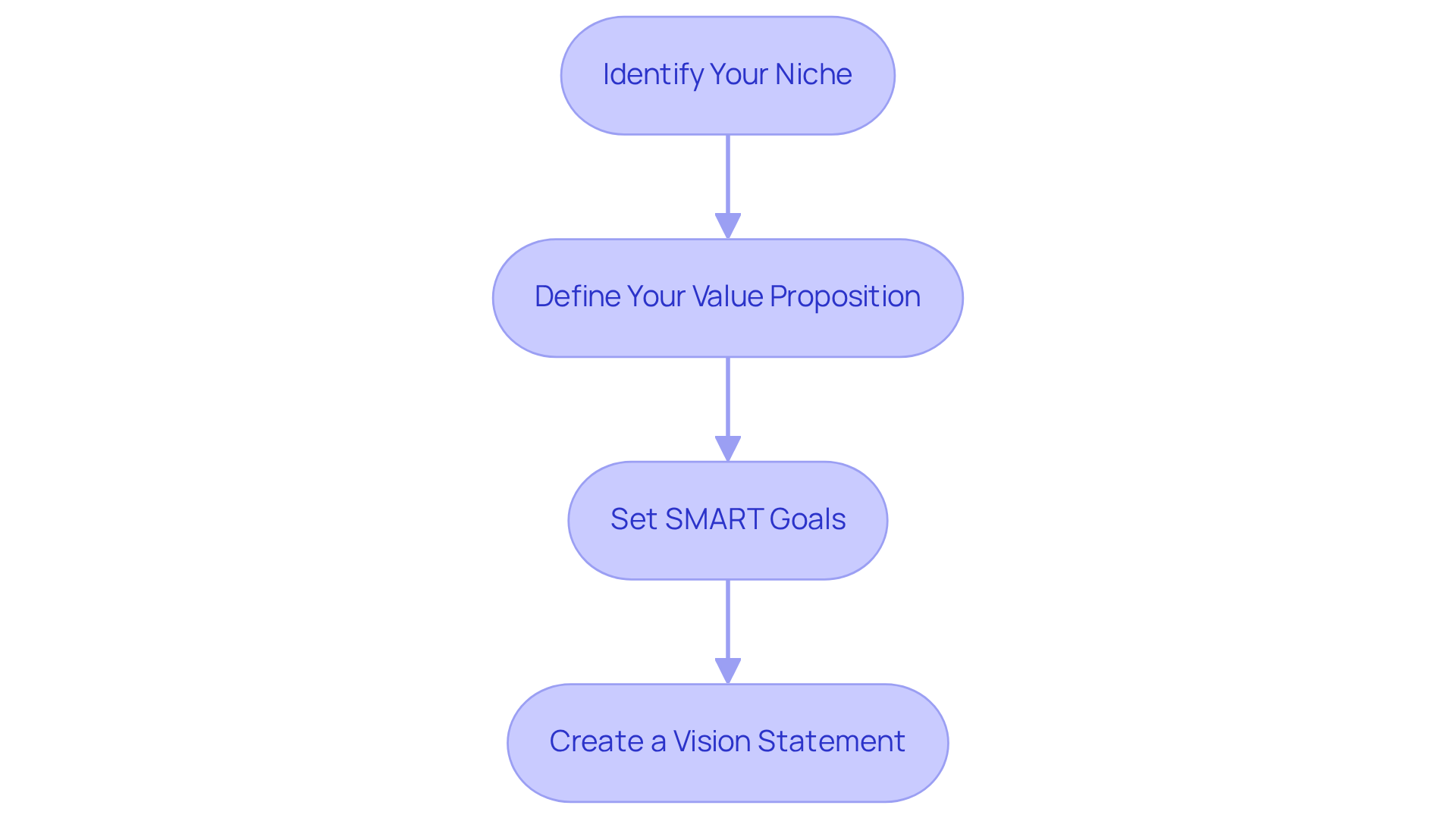
Establish Legal Structure and Compliance Requirements
-
Choose an Organizational Structure: Selecting the appropriate organizational framework is vital for technology firms in 2025. Options include Sole Proprietorship, Partnership, Limited Liability Company (LLC), and Corporation. Each structure has distinct implications for liability, taxation, and operational flexibility. For instance, LLCs offer personal liability protection, which is crucial in the tech industry where legal risks can be significant. In 2025, it is projected that a substantial percentage of software development businesses will operate as LLCs, reflecting the industry's preference for structures that mitigate personal risk while allowing for operational flexibility.
-
Register Your Enterprise: After determining the appropriate structure, it is essential to register your venture with the relevant government authorities. This process typically involves submitting specific paperwork and paying registration fees. In the UK, this can be accomplished through Companies House, which streamlines the registration process for new enterprises.
-
Acquire Essential Licenses and Permits: It is important to investigate the licenses and permits needed for your technology enterprise, as these can differ depending on location and sector. For example, technology firms handling sensitive data may need to comply with GDPR regulations, which mandate strict data protection measures.
-
Understand Compliance Requirements: Navigating legal compliance is essential for technology firms. Familiarize yourself with industry regulations, such as GDPR for data protection and other relevant laws. A considerable 51% of tech leaders recognized security as a major challenge in technology creation for 2025, underscoring the necessity of adhering to compliance standards to mitigate risks. Additionally, 31% of IT teams prioritize maintaining compliance and security, reflecting the industry's emphasis on these critical areas. Companies like Itransition have successfully navigated these challenges by implementing robust compliance frameworks, ensuring they meet legal obligations while fostering trust with clients. As noted by industry experts, "Compliance is not just a legal requirement; it's a strategic advantage that builds customer confidence and loyalty.
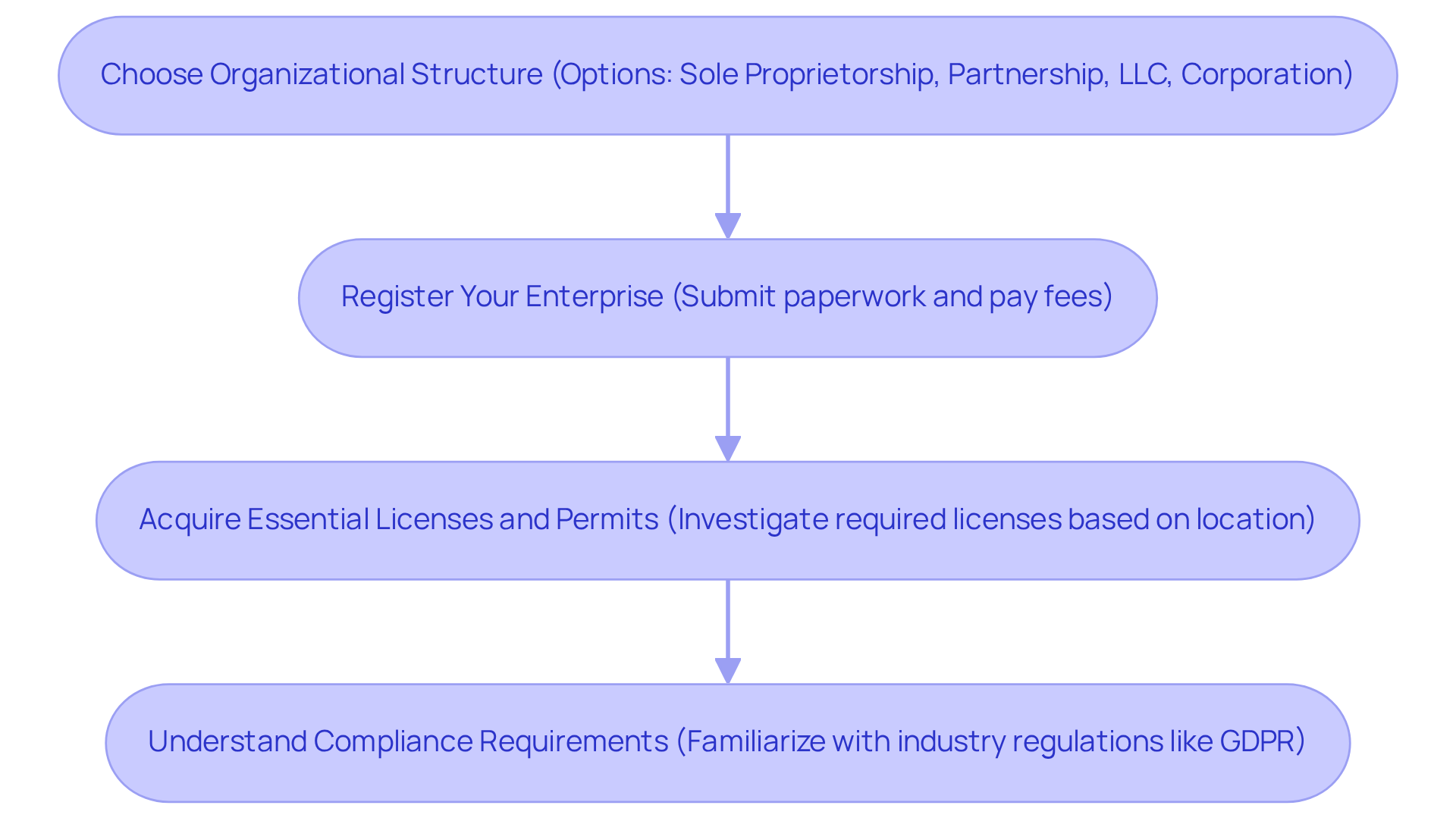
Develop a Comprehensive Business Plan
A thorough industry analysis is crucial for any software development business seeking to succeed in a competitive environment. This process involves a deep dive into various aspects of the market, including demographics, market size, and competitive dynamics. By understanding the target audience, businesses can tailor their offerings to meet specific needs, ultimately driving user engagement and satisfaction.
In 2025, the demographics of application users are anticipated to change considerably, with a significant rise in mobile banking users expected to exceed 4.8 billion worldwide by 2028. Additionally, global digital payment application users are estimated to exceed 4,805 million by 2028. This shift emphasizes the significance of modifying technological solutions to serve a varied user group, especially in areas such as fintech, where income from NeoBanks alone could attain $364.6 billion by 2026.
To effectively conduct market analysis, technology companies should employ a variety of strategies. Utilizing quantitative data, such as the projected compound annual growth rate (CAGR) of offshore technology services at 10.13% from 2024 to 2031, can provide insights into growth opportunities. Moreover, it is essential to recognize that only 29% of software creation projects achieve success, while 52% encounter difficulties. This highlights the importance of comprehensive analysis in enhancing project results. Qualitative research techniques, such as customer input and ethnographic studies, can reveal user preferences and challenges, directing product enhancement.
Real-world examples demonstrate the importance of analysis in software development. For example, businesses that utilize customer insights frequently observe enhanced product alignment with consumer needs. A case study involving Specsavers demonstrated how utilizing customer data through platforms like InsightHub informed their marketing strategies, leading to more effective decision-making. The insights gained from customer feedback were crucial in shaping their offerings to better address consumer needs.
In summary, performing a comprehensive analysis of the industry is not merely an initial step; it is a strategic requirement for software companies. By understanding market dynamics and user demographics, companies can position themselves for success, ensuring their products resonate with the intended audience and meet evolving market needs.
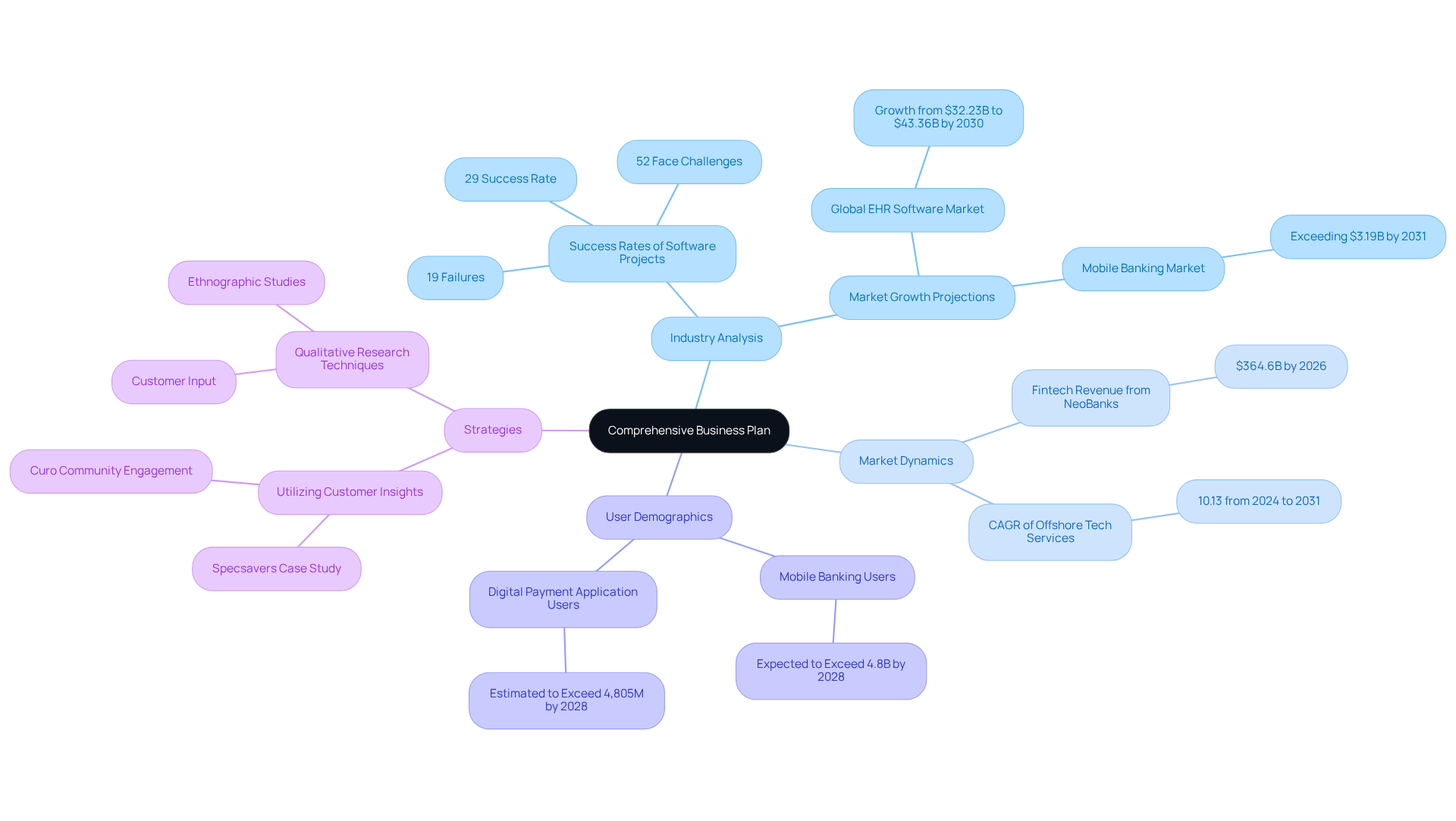
Secure Funding and Assess Financial Needs
-
Determine Your Funding Needs: Begin by evaluating the capital necessary to start and maintain your enterprise until it achieves profitability. This assessment should encompass costs related to development, marketing, and operational expenses. While the typical expense to launch a venture hovers around $40,000, it is crucial to note that 31% of startup capital for employer firms falls below $10,000, highlighting the diverse funding requirements across various enterprises.
-
Explore Funding Options: Investigate a spectrum of funding sources available for tech startups, including personal savings, loans, angel investors, venture capital, and crowdfunding. Each option presents its own unique advantages and challenges. Notably, in Q2 2025, global venture funding reached an impressive $91 billion, with AI startups attracting nearly $19 billion—28% of the total funding—underscoring the escalating interest in technology ventures.
-
Prepare a Pitch Deck: Craft an engaging pitch deck that effectively conveys your strategy, market opportunity, and financial forecasts. Successful pitch decks are paramount when engaging potential investors. For instance, GANI has assisted startups in creating impactful investor presentations that articulate their value propositions clearly, significantly enhancing their chances of securing funding. In one notable case, GANI helped a startup in the augmented reality sector achieve 100% of its funding goal within 90 days through a well-prepared pitch deck.
-
Apply for Grants and Competitions: Actively seek out grants and startup competitions that offer funding without requiring equity. These opportunities can prove invaluable for early-stage ventures aiming to minimize financial risk while gaining exposure. Participating in such competitions not only presents potential funding but also aids in refining your business model and networking with industry professionals.
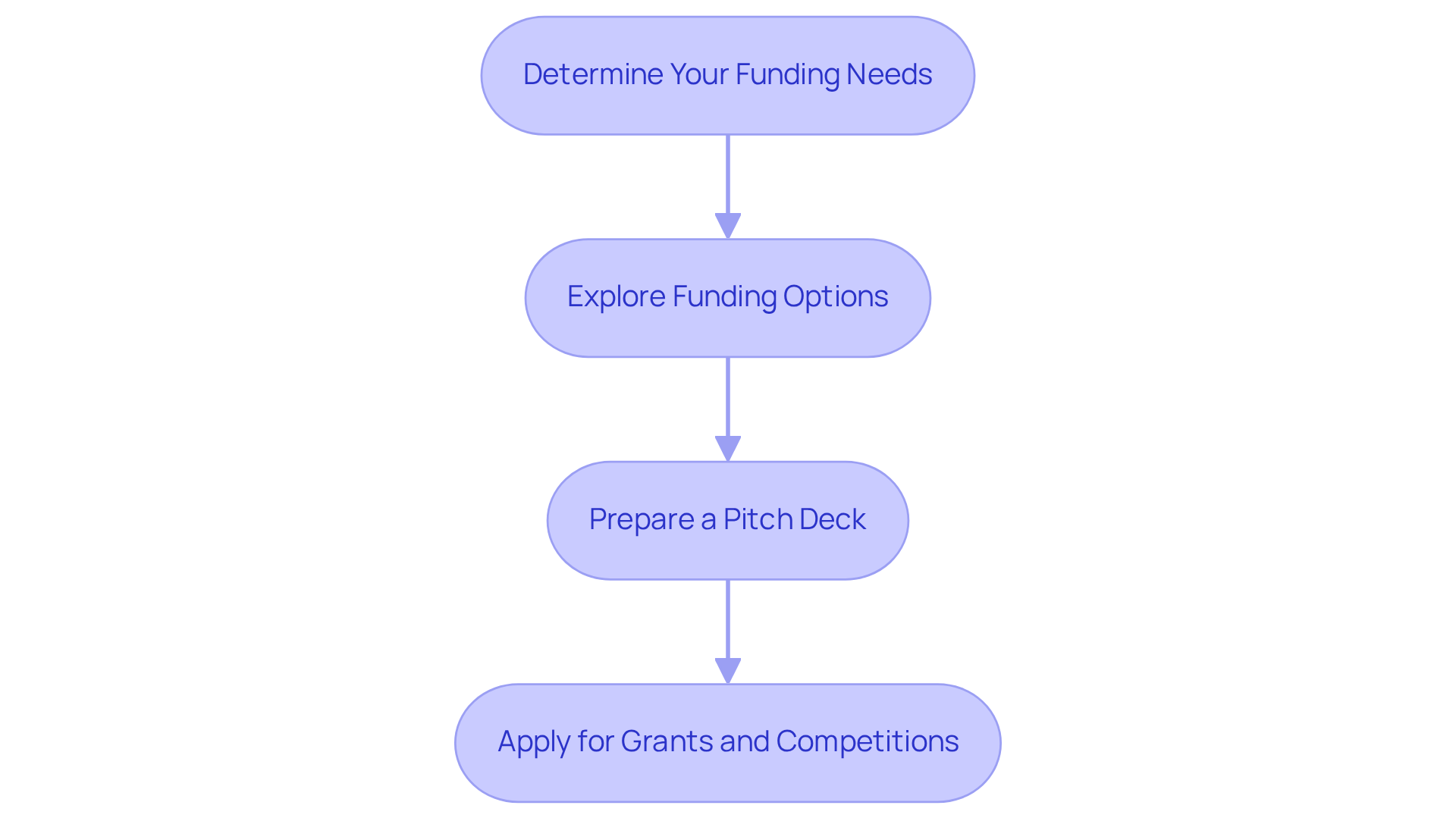
Recruit and Build Your Development Team
-
Define Roles and Responsibilities: Clearly identify the essential roles for your development team, including developers, UX/UI designers, and project managers. Each role must have well-defined responsibilities to ensure clarity and accountability within the team.
-
Create Job Descriptions: Craft clear and compelling job descriptions that emphasize the necessary skills and experience for each position. Highlighting specific qualifications will attract the right candidates and streamline the recruitment process.
-
Utilize Recruitment Platforms: Leverage platforms such as LinkedIn, GitHub, and specialized tech job boards to source and attract top talent. Additionally, tapping into your professional network for referrals can significantly enhance your recruitment efforts, as 72% of organizations find that referrals yield better access to skilled candidates. The global IT services outsourcing market size of $744,623.5 million in 2024 underscores the competitive landscape for tech talent.
-
Conduct Thorough Interviews: Establish a structured interview process that evaluates both technical competencies and cultural fit. This dual approach is essential for creating a cohesive and effective team, as 61.9% of professional developers hold degrees in relevant fields, highlighting the significance of aligning educational backgrounds with your team's requirements.
-
Average Salaries for Developers in 2025: As of 2025, the average salary for developers in the U.S. is projected to be around $95,000 annually, with entry-level positions starting at approximately $80,000 and experienced professionals earning upwards of $137,234. Understanding these salary benchmarks is vital for attracting and retaining top talent.
-
Examples of Successful Recruitment Strategies in Tech: Companies that prioritize diversity and inclusion in their hiring practices often see improved performance and innovation. For instance, organizations that implement mentorship programs report higher retention rates and employee satisfaction. Additionally, with the anticipated increase of programming engineers by 22% by 2029, efficient hiring strategies are more crucial than ever.
-
Best Recruitment Platforms for Tech Talent in 2025: In addition to LinkedIn and GitHub, platforms like Stack Overflow and AngelList are gaining traction for tech recruitment. These platforms cater specifically to tech professionals, making them valuable resources for finding specialized talent.
-
Quotes on Defining Roles in Tech Startups: "Defining clear roles within a startup is essential for fostering collaboration and ensuring that each team member understands their contribution to the overall mission." This perspective underscores the importance of role clarity in achieving startup success. Furthermore, as 50-70% of technology development projects fail due to common issues, hiring the right talent is essential for reducing risks.
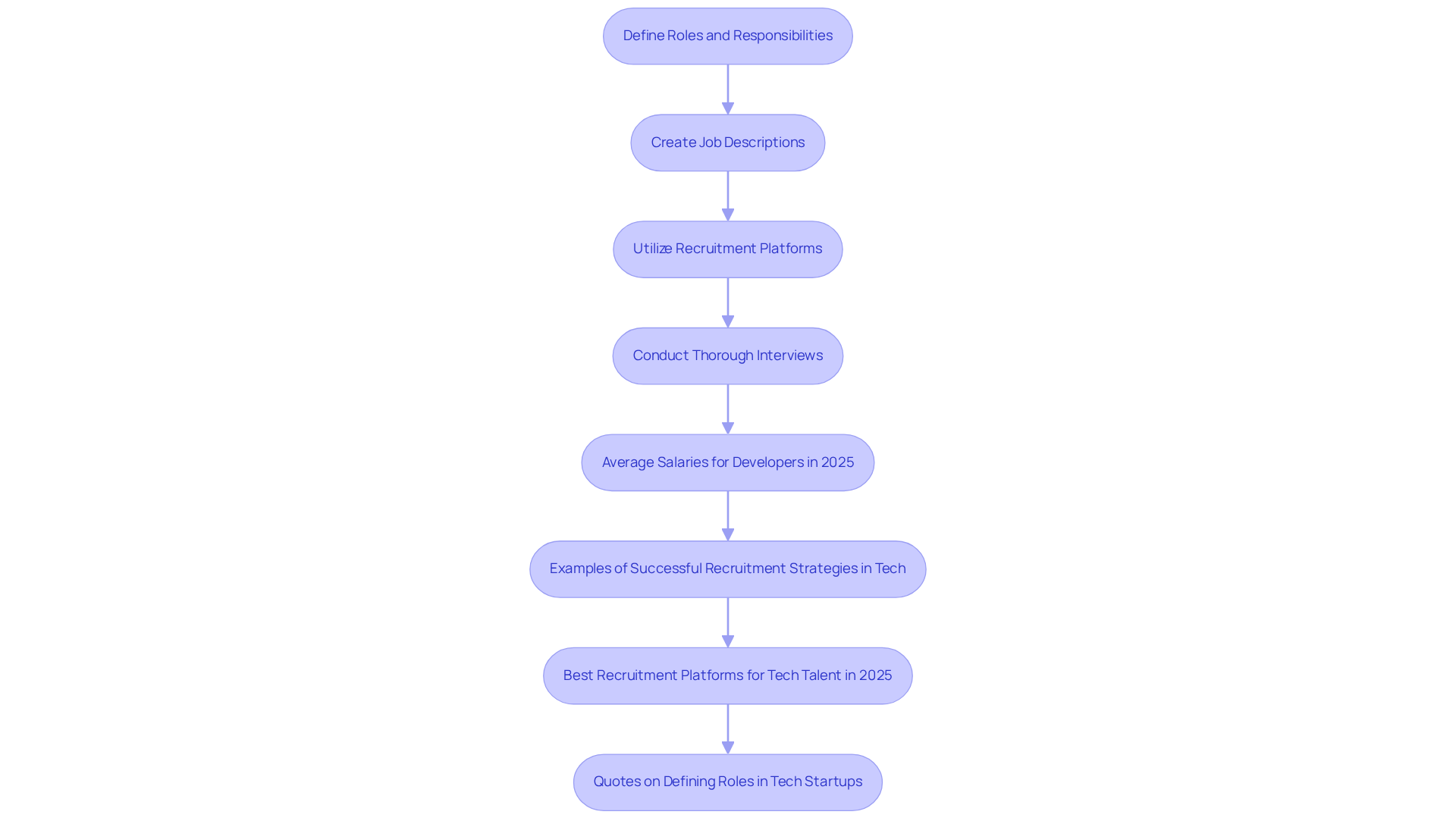
Implement Marketing Strategies for Your Software Products
-
Develop a Strong Online Presence: Establish a professional website and engage actively on social media platforms to showcase your products. A strong online presence not only reflects the brand identity of your software development business but also fosters trust with potential customers. In 2025, 74% of users are more likely to revisit a website optimized for mobile, highlighting the necessity for a user-friendly design.
-
Content Marketing: Produce valuable content that addresses the specific pain points of your target audience. This can include blog posts, tutorials, and case studies that demonstrate your expertise in the software development business and showcase the effectiveness of your solutions. For example, 87% of marketers indicate that video marketing significantly boosts website traffic, positioning it as a powerful engagement tool.
-
Leverage SEO: Optimize your website and content for search engines to improve visibility. Incorporate relevant keywords to ensure that your software development business site is user-friendly. With over 63% of online interactions beginning with a search engine, effective SEO strategies are vital for drawing organic traffic.
-
Utilize Paid Advertising: Invest in paid advertising on platforms such as Google Ads and social media to expand your reach. Target your ads to specific demographics to enhance effectiveness. In 2025, companies that adopt a multi-channel approach can anticipate an average of 50% greater return on investment (ROI), positioning targeted advertising as a key element of your marketing strategy.

Protect Your Intellectual Property and Business Assets
-
Understand IP Rights: It is essential to familiarize yourself with the various types of intellectual property rights, including copyrights, trademarks, and patents. Each type offers distinct levels of protection, which are crucial for safeguarding your innovations.
-
Register Your IP: Take the necessary steps to register your application and any associated trademarks. In 2023, trademark applications saw a 2% decrease, totaling 15.2 million classes, highlighting the competitive landscape in IP protection. This legal registration is vital for defending against unauthorized use.
-
Implement Non-Disclosure Agreements (NDAs): When discussing your software with potential partners or employees, utilize NDAs to protect sensitive information. This practice is key to safeguarding your innovations and maintaining confidentiality.
-
Regularly Review and Update Protections: As your business evolves, it is important to regularly assess and update your IP protections to ensure their effectiveness against new threats. WIPO emphasizes that adapting IP strategies is essential for maintaining a competitive advantage in the market.
-
Trademark Registration Statistics: In 2025, trademark applications for technology firms are projected to reflect a significant trend, with a notable number of classes filed. This underscores the growing recognition of the importance of IP protection in the tech industry.
-
Steps to Register Intellectual Property for Digital Products: Begin by identifying the type of IP applicable to your digital creation. Next, gather the necessary documentation and submit your application to the relevant IP office. This structured approach streamlines the registration process.
-
Examples of software development businesses registering IP rights: Include numerous successful software companies, such as Thalmic, which holds hundreds of patents critical for competition and have prioritized IP registration. This showcases how effective protection can lead to sustained innovation and a competitive advantage in the marketplace.
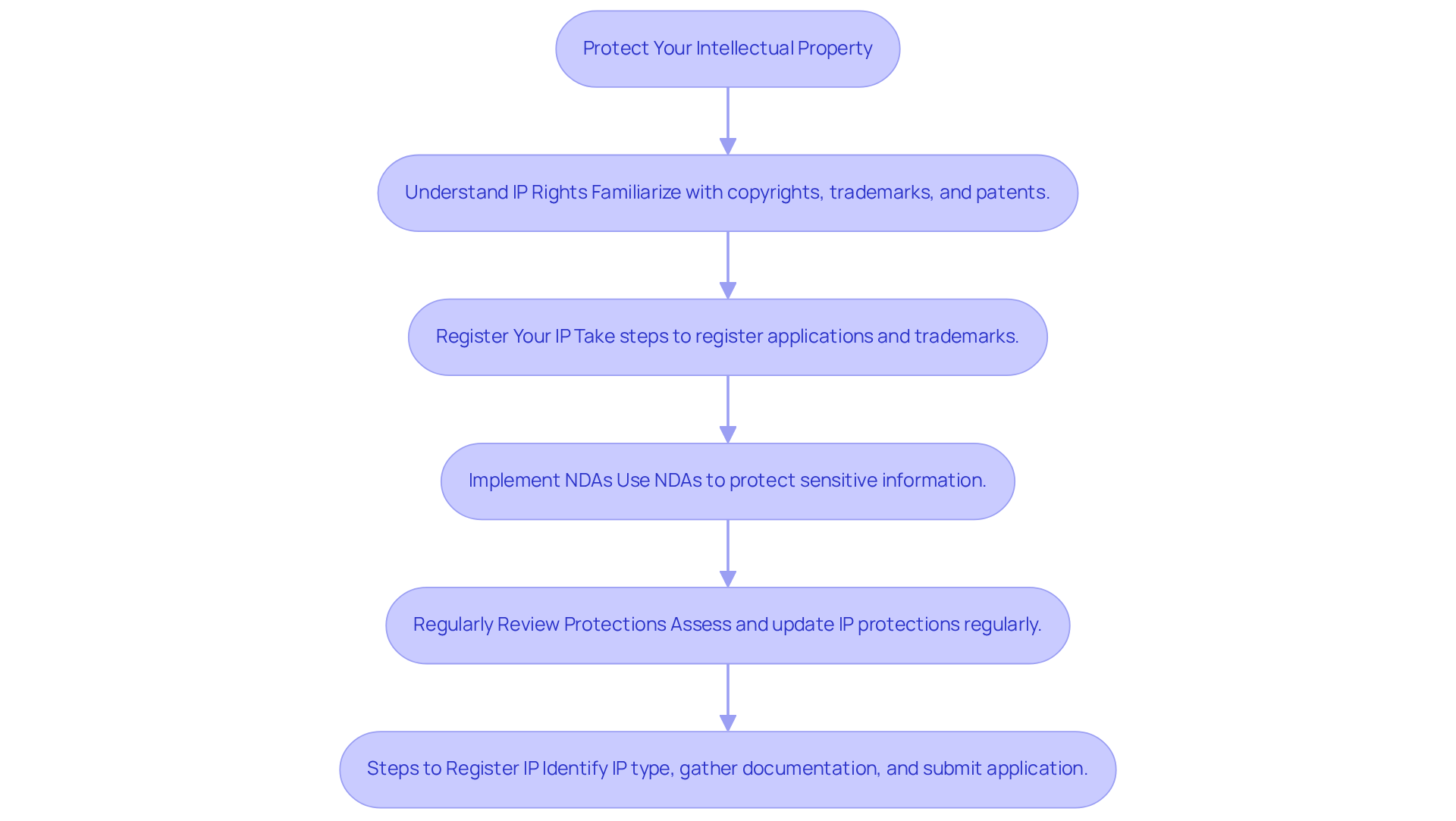
Conclusion
Establishing a software development business requires a strategic approach that encompasses several critical steps. By clearly defining the business concept, setting specific goals, and establishing a robust legal structure, entrepreneurs lay a solid foundation for their ventures. Understanding market dynamics and securing adequate funding are equally essential, as they enable the business to navigate the competitive landscape effectively. Furthermore, building a skilled development team and implementing effective marketing strategies are vital for driving growth and achieving long-term success.
This guide has shared key insights, including:
- The importance of a comprehensive business plan
- The necessity of compliance with legal requirements
- The need to protect intellectual property
Each step, from identifying a niche to recruiting top talent and safeguarding innovations, plays a pivotal role in the overall success of a software startup. By following these structured steps, aspiring entrepreneurs can significantly enhance their chances of launching a successful software development business.
Ultimately, the journey of establishing a software development business transcends mere checklists; it involves embracing innovation, understanding market needs, and fostering a culture of adaptability. As the tech landscape continues to evolve, staying informed and proactive is crucial. For those prepared to embark on this exciting venture, leveraging the insights and strategies outlined in this guide can transform aspirations into reality, paving the way for a thriving software enterprise.









